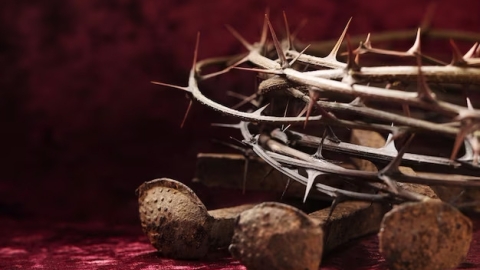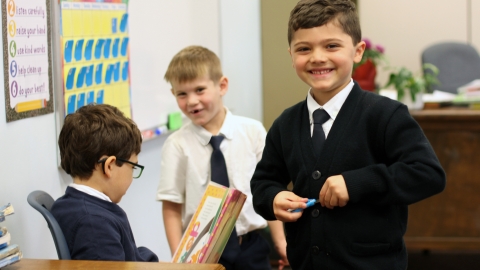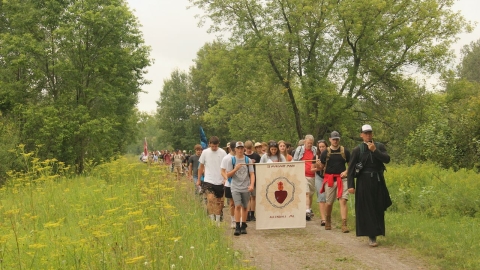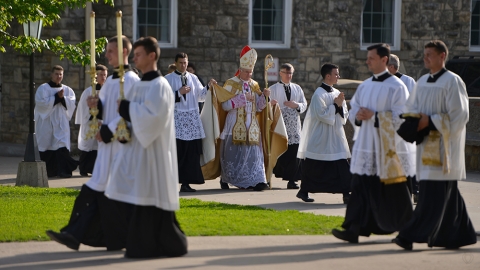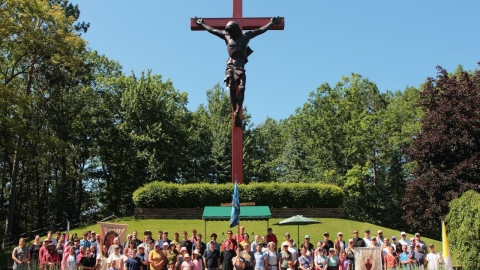Tradition: solution for priestly crisis

If the "experiment of Tradition" is implemented, the ever-declining number of priests (and religious) that is being experienced by dioceses throughout the world can be reversed.
The editor of DICI, Fr. Lorans, offers a brief commentary—and then a challenge from Tradition—on the tragic state of affairs afflicting the Church in France concerning the number of priests.
In contrast to the dire situation faced by French dioceses (see the following news article for more details), the Society of St. Pius X continues to flourish as testified by its recent priestly ordinations:
- 2 more priests ordained at Zaitzkofen (Germany)
- 7 priests ordained at Econe (Switzerland)
- 4 new priests ordained for the SSPX (Winona, MN - USA)
In consequence of this year's ordinations, the SSPX now numbers over 600 priests.
In fact, as made clear by Fr. Wegner's recent Future Fund appeal letter for the New Seminary Project (see the sidebar video), the SSPX's North American seminary is "suffering" from a different sort of decrease—a lack of room for the training of priests!
From denial to challenge
This year there were only 68 ordinations of diocesan priests throughout all of France and 52 ordinations of religious for a total of 120 new priests. It is predicted that there will be only 6000 priests in France in 5 years as compared to 15,000 today, because 10,000 of them are over 65 years of age, and 7000 are over 75.
How will 6000 priests be able to serve parishes? The head of the Great Mosque of Paris has some ideas for putting former churches to good use in France (Europe 1, 6-15-2015), and Bishop Michel Dubost of Evry, who “prefers that churches become mosques rather than restaurants,” will be able to hand over the keys to him.
Faced with this inexorable drop in ordinations, specialist committees offer sociological explanations and expert consultations suggest psychological interpretations, while the conclusion is more demographically obvious every day: there are not enough new priests to replace the priests who die.
This critical situation led one bishop to ask several years ago for permission to “make the experiment of Tradition.” But in the name of an ideological a priori, his request was denied: the Council is non-negotiable, post-conciliar reform is irreversible, the numbers that contradict it must be “Lefebvrist,” and must be treated accordingly with the disdain… Such is the denial of reality.
But the facts are always there, and the experiment of Tradition can still be made. But for that to happen we must make an energetic denial that this decline is our destiny, and there must be a will to make use of the treasures offered by the Tradition of 2000 years… Such is the challenge!
Fr. Alain Lorans | DICI no. 318
France: Drop in the number of ordinations this year
Le Figaro of July 7, 2015, indicates that “the number of priests ordained in France has never been so low.” Indeed, the French bishops’ conference announced 68 ordinations of diocesan priests in 2015, down from 82 in 2014. Together with the 52 ordinations of priests from religious orders, this makes up 120 priests (diocesan and religious) who are ordained for the year 2015, as compared to 140 last year. This is the lowest number in the last 15 years.
The future is hardly brighter, for only 87 diocesan seminarians were ordained to the diaconate in 2015 and are due to become priests next year. As Figaro columnist Caroline Picquet writes,
the chronic drop in the number of priests in France has been concerning the bishops for a long time. The number of Catholic priests in France was almost halved over 20 years, moving from 29,000 (diocesan and religious priests together) in 1995 to around 15,000 in 2015. Experts predict that there will be only 6000 priests in France by 2020."
10,000 of them are over 65, and 7000 are over 75. And one bishops recognized the plain facts: “I ordain one priest per year, while I bury 12.” This means that many French bishops have not ordained a priest for 10 years.
Le Figaro accepts this commentary fatalistically:
In the diocese of Toulouse, the chancellor Christian Teysseyre has observed this permanent fluctuation from one year to the next. ‘On average, we have 1.5 ordinations per year, but this year we have not had any diocesan ordinations,’ he reports. ‘This is not the first time this has happened, it depends on the year. In 2016, for example, we expect to have three.’ In the diocese of Orleans, it varies a good deal. ‘This year, we have one ordination, versus four in 2014,'”
explains a layman involved with the Church who preferred to remain anonymous. 2012 and 2013 were more difficult years: “no ordinations.”
This drop in ordinations is invariably accompanies, throughout the decades, a drop in the number of participants: in 1952, 27% of Catholics attended Mass; in 2010, only 4.5%, according to a study conducted by IFOP.
(Sources: Figaro—CEF—IFOP—DICI no. 318, 10-7-2015)
